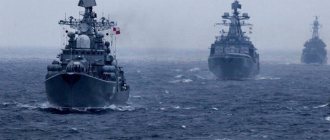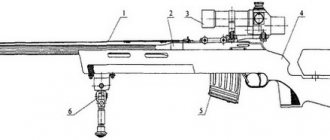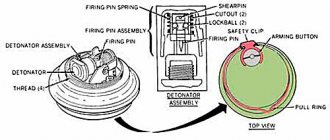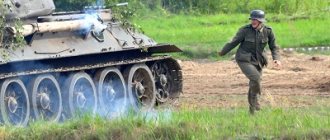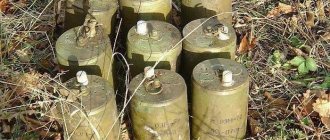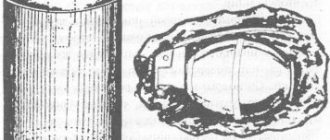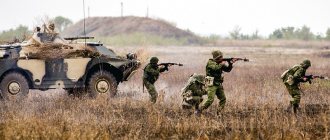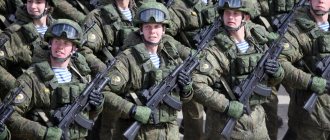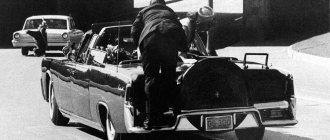Wehrmacht anti-tank weapons
Like the USSR, Germany entered the war with a limited number of mine weapons. The emphasis in the new armed conflict was on attacking actions, so engineering and special weapons remained in the background. Later, when the Wehrmacht faced fierce resistance from the Red Army, when Soviet troops began to take counterattacking actions, the Germans had to resort to mine weapons.
The history of the development of mines in Germany is identical to the processes occurring in the Soviet Union. Back in 1929, the German anti-tank mine Tellermine 29 was created. Later, with Hitler coming to power, German military engineers began work on creating anti-personnel and anti-tank mines. Unlike Soviet weapons, where the main anti-tank mine TM had a powerful high-explosive charge and a pressure-action fuse, German explosive devices carried a smaller main charge. However, the number of fuses was increased to three, which increased the likelihood of the ammunition going off.
Mine from above
New technologies and principles allow the mine not just to passively wait for a target, but to attack the enemy from the most unexpected directions - for example, from above.
The famous German tank general Guderian believed that the main danger to a tank was the enemy tank, followed by the anti-tank gun, and the third by anti-tank mines. Airplanes are in fourth place: if mines disabled about 23% of tanks, then aviation only 4%.
In an effort to protect themselves from anti-tank guns, designers made tank armor thicker, to which artillerymen responded by increasing the caliber and speed of the projectile (at the beginning of World War II, the thickness of the armor usually did not exceed 15-20 mm, and the caliber of guns - 45 mm, and at the end of the war the thickness armor reached 200 mm, and the caliber of anti-tank guns - 100 mm and more). Today, tank armor in its protective properties is equivalent to 500–750 and even 850 mm, and the penetration capacity of anti-tank missiles (ATGMs) has increased to 900–1000 mm. Anti-tank mines have not been left out of this race either.
Hit from below
From the very beginning, anti-tank mines were aimed at the most vulnerable parts of the tank - the chassis, bottom and side.
At the beginning of World War II, anti-track mines predominated among anti-tank mines. All other types were represented by only two samples - the Soviet anti-bottom mine AKS and the Soviet anti-aircraft mine LMG.
Despite the fact that the weight of the warhead of an anti-tank mine during the war and post-war period increased from 2 kg to 10 kg and even more, an anti-track mine rarely disables a tank completely. More often than not, only the chassis suffers, which can be restored. This circumstance, as well as the successes in the development of mine countermeasures (mine trawls), led to the development of anti-bottom mines. These mines destroy the tank, rather than just temporarily disabling it. And the explosive charge can be significantly smaller - after all, it only needs to penetrate the very thin armor of the bottom.
And yet, there remained an “Achilles heel” common to all mines: the mine is located on a minefield, and its target sensors - devices that detect the tank and issue a command to detonate the mine - are installed either on the mine itself or next to it. Meanwhile, new mine sweeps were created that made the mines go off without waiting for the tank to approach. Moreover, it is easier to make such trawls than devices against pressure anti-track mines. If the target sensor of an anti-bottom mine is a pin sticking out of the ground, then it is enough to stretch the chain between the rollers of the trawl so that it causes the mine to explode prematurely. It’s even easier to deceive the miracle of mine-explosive technology of the second half of the 20th century - magnetic fuses. It is enough to attach a pair of induction coils to the frontal armor of the tank, powered by the on-board electrical network, and they will create a magnetic field in front of the tank, which will cause the mine to explode prematurely.
Flank attack
The creators of mines had to turn their attention again to the sides of the tank, especially since very effective hand-held anti-tank grenade launchers already existed. All that remained was to equip them with appropriate target sensors that would react to the tank and issue a command to fire a grenade launcher. This is exactly how the Soviet TM-73 mine, the American M24 and M66, and the English Adder are designed. Such a scheme eliminated the need to place an anti-tank mine in a minefield. A mine (grenade launcher) can be placed to the side, at a distance of up to 200 m from the minefield. It has become standard to equip the mine with two target sensors. The first - seismic, or geophonic - detected the approach of a tank by shaking waves or sound waves diverging in the ground. The second target sensor, which was turned on at the command of the first sensor, is infrared, detecting the tank by engine heat. The mine control system only had to determine the most advantageous moment and issue a command to fire the grenade launcher.
Still, anti-aircraft mines have a number of significant disadvantages. First of all, the grenade launcher's shot itself does not necessarily mean that the tank will be destroyed. The grenade may be blown off course by the wind, and the tank's speed may be too high or too low. The grenade may fly behind or in front of the tank and fail to complete its task. In addition, mines have to be camouflaged, and care must also be taken to ensure that there are no obstacles in the grenade’s flight path (bushes, tall grass, various objects) that could throw the grenade off course or lead to its premature explosion. It is clear that such a mine can only be placed manually.
These shortcomings were partially overcome by replacing the grenade with an impact core (as, for example, it was done in the Soviet anti-aircraft mine TM-83). The impact core's flight speed is supersonic; its flight is not affected by weather conditions or minor interference in the form of grass or bushes.
But the tank may not go in the direction the miners expected. What should we give? The eyes of the anti-tank mine designers turned... to the sky. This is the perfect place to place mines! The projection of the tank from above is the largest. The roof armor is the thinnest. The thermal radiation of the engine is the most stable. This means that it is best and easiest to hit the tank from above.
But it is impossible to keep a mine in the sky for a long time, and sometimes it has to wait in the wings for months. This means it needs to be placed in the ground. In the ground, but hits from above? Paradox?
Soviet anti-aircraft mine TM-83 fires an impact cannonball at a tank from the side.
Predatory Hornet
Apparently, the American WAM M93 Hornet mine should be considered the first example of such a mine. Its development began back in 1986. Since it was planned to develop four variants of this mine and the nature of its action on the target was very different from all previously known, they were united under the common name Family of Wide Area Munitions (WAM), roughly translated into Russian - “Family of ammunition having a significant area of control.”
The first member of the family is HE-WAM. This is a mine that is installed and brought into firing position manually. Reversion to a safe position is not provided, but the mine has a self-destruction system.
HE-Hornet PIP#1 is an improved, more expensive version: this mine can be switched to a safe position using a radio remote control and reinstalled. Option three - HE-Hornet PIP#2 - is capable of detecting not only tanks, but also light wheeled vehicles. And finally the fourth - DA-Hornet: this mine can be installed using missiles or aircraft. The combat life of the mine, which weighs about 16 kg, is up to 30 days, after which it self-destructs.
The idea of using such mines is tempting, since the destruction of the tank is guaranteed. But, having started work on the mine back in 1986, the Americans were able to complete it only in 1997. Tests carried out in September 1997 at a training ground in Arizona showed that everything was not so rosy - out of six mines, only three reacted to the T-72 tank, only one of them hit the target. Further tests revealed a significant impact on the combat performance of mines from low and high temperatures, strong wind (more than 5 m/s), snowfall, rain, smoke or dust.
The development and production of the first batch of these mines will cost taxpayers $800 million. Moreover, despite the almost complete failure of the tests, it is planned to purchase 15,259 mines (one piece costs about $52,400). As of the end of 2005, the test program had not been completed, but already in June 1999, in the American Field Manual FM 20-32, this mine appeared as ammunition in service with the US Army.
Russian version
What about Russia? Our designers are also working on the idea of hitting enemy tanks from above, but they took a different path, finding, as politicians like to say, an “asymmetric response.” The Russian army today is not able to purchase mines at $52,000 apiece or even pay for their development. However, “the need for invention is cunning” - so a simple, ingenious and cheap solution was found.
At the international exhibition of technical means of defense and defense (Russian Defense Expo-2001), held in July 2001 at the Staratel training ground of the Nizhny Tagil Metal Testing Institute, the Moscow Research Machine-Building Institute NIMI showed ammunition of a similar purpose, which was officially called “Engineering ammunition with a cluster warhead for defeating groups of manpower and lightly armored vehicles M-225.”
The M-225 is equipped with a combined target sensor, which includes seismic, magnetic and thermal sensors. If the mine is in combat alert mode, then when a target enters the detection zone (radius 150–250 m), the sensors inform the control panel about the nature of the object (person, machine), number of targets, speed and direction of movement, distance to the affected area. The control panel processes incoming signals and gives the operator recommendations: is it advisable to detonate mines, which mines that are on combat duty should be detonated, how many mines that are in passive mode should be transferred to combat duty. If targets are simultaneously in the affected areas of several mines, then recommendations are given which one should be detonated. It is interesting that this ammunition, being essentially an anti-personnel/anti-vehicle mine, does not fall under the jurisdiction of either the Ottawa Convention or the Protocol of the Second Geneva Convention. Its name does not contain the word “mine” (it is “engineering ammunition”). Additionally, according to Article 2 of the Ottawa Convention, "'mine' means a munition designed to be placed underground, on or near the surface of the earth or other surface and to explode when caused by the presence, proximity or direct impact of a person or vehicle." And this mine explodes only at the command of the operator - so it can be considered an artillery piece - say, a “stationary 600 mm caliber mortar.” By the way, it is very easy to make it uncontrollable. It is enough to abandon the control panel and the operator and attach to it the control unit of the Okhota anti-personnel mine set (or even a simple MUV fuse with a tension wire) and cut a couple of wires in the sensor block. Any engineer sergeant can handle this.
Mines: heyday or decline?
Today, the situation that took place before World War II is being repeated. At that time, mines as weapons were underestimated, they were not given any attention, and already during the war, they had to urgently develop acceptable samples of mines, hastily train personnel, and at the same time suffer heavy losses due to the inability to cover their positions with this simple, but very effective weapon.
Will the modern development of military technology and, in particular, the presence of high-precision cruise missiles and guided artillery shells force us to abandon mines? Hardly.
“... Future battles will involve high speeds, large territories, but relatively small armies,” writes English military historian Mike Kroll. – The ability of mines to quickly block territories and destroy the enemy with little financial and labor costs will be decisive in defense.
The role of mines will be expanded to such an extent that its original form will be barely recognizable. It is no longer required that the victim physically activate the mine; the mine itself will find its target - a tank, a helicopter, perhaps even a jet or a satellite - and will deploy its deadly warhead in its direction. Modern electronics and new methods of searching for targets can increase the effectiveness of mines. The technical capabilities of future mines will be limited only by the diabolical ingenuity of man.”
Wehrmacht anti-tank mines
During the First World War, the use of field mines played a subordinate role, despite the fact that static trench warfare created ideal conditions for the use of this type of weapon. At the same time, massive artillery fire made any minefield basically ineffective. For this reason, mines remained far in the background.
During the time of the Reichswehr, the project of the first German anti-tank mine (Tank-Minen, T-Mine) turned out to be impractical. The mine was designated “T-Mine 29” and weighed six kilograms. By decision of the Reich War Ministry in the spring of 1935, it was replaced with a new ammunition, “T-Mine 35”.
Subsequently, the T-Mine 35 became the main anti-tank weapon for engineering units, as well as sapper platoons in other branches of the military. This standard anti-tank mine weighed almost 10 kg and had a 5.45 kg explosive charge capable of penetrating up to 10 cm of steel armor.
By 1943, the industry of the Third Reich had produced about 4.2 million copies of the T-Mine 35. Before the war, the Wehrmacht engineering battalion, staffed according to the staff, had an arsenal of 1,500 such mines.
Pre-war exercises. The soldiers of the sapper company, having two T-Mine 35 anti-tank mines, turn around to lay a minefield.
Application options
Mines of this model could be used in several ways. If minefields were deployed, in accordance with the stipulated standards, they were installed in the ground at intervals of four to eight meters. In this case, a pressure-action fuse was used.
To fight tanks at close range, Wehrmacht soldiers used the T-Mine 35 with a detonator with a delay of 10 to 15 seconds. In this case, the mine was either thrown onto the stern of a moving enemy tank, or placed under its track or hull. Considering the significant total weight of the mine and its diameter of 32 cm, such actions required special skill and strong-willed qualities.
From the propaganda magazine Signal. Chief Corporal in a trench on the front line with two T-Mine 42 anti-tank mines.
As German historians note, by the beginning of World War II, the Wehrmacht engineering troops in standard equipment experienced a huge shortage of mines. A large number of anti-tank mines were in close proximity to the bunker fortifications of the Western Wall and should have remained there. Anti-personnel mines “S-Mine 35” (Schützenminen, S-Mine), which began to arrive around 1938, were also stored there. Therefore, Hitler’s troops pulled out their first “blitzkrieg” in Poland, Scandinavia, France and the Balkans with their minimal reserves.
Excerpt characterizing TM-89
Pierre arrived earlier to find them alone. Pierre had gained so much weight this year that he would have been ugly if he had not been so tall, large in limbs, and so strong that he obviously carried his weight easily. He, puffing and muttering something to himself, entered the stairs. The coachman no longer asked him whether to wait. He knew that when the count was with the Rostovs, it was until twelve o’clock. The Rostovs' lackeys joyfully rushed to take off his cloak and accept his stick and hat. Pierre, as was his club habit, left his stick and hat in the hall. The first face he saw from the Rostovs was Natasha. Even before he saw her, he, taking off his cloak in the hall, heard her. She sang solfege in the hall. He realized that she had not sung since her illness, and therefore the sound of her voice surprised and delighted him. He quietly opened the door and saw Natasha in her purple dress, which she had worn at mass, walking around the room and singing. She walked backwards towards him when he opened the door, but when she turned sharply and saw his fat, surprised face, she blushed and quickly approached him. “I want to try singing again,” she said. “It’s still a job,” she added, as if apologizing. - And wonderful. – I’m so glad you came! I'm so happy today! - she said with the same animation that Pierre had not seen in her for a long time. – You know, Nicolas received the St. George Cross. I'm so proud of him. - Well, I sent an order. Well, I don’t want to disturb you,” he added and wanted to go into the living room. Natasha stopped him. - Count, is it bad that I sing? - she said, blushing, but without taking her eyes off, looking questioningly at Pierre. - No... Why? On the contrary... But why are you asking me? “I don’t know myself,” Natasha quickly answered, “but I wouldn’t want to do anything that you wouldn’t like.” I believe you in everything. You don’t know how important you are to me and how much you have done for me!..” She spoke quickly and not noticing how Pierre blushed at these words. “I saw in the same order, he, Bolkonsky (she said this word quickly, in a whisper), he is in Russia and is serving again. “What do you think,” she said quickly, apparently in a hurry to speak because she was afraid for her strength, “will he ever forgive me?” Will he have any ill feelings against me? How do you think? How do you think?
Explosive nature: the most dangerous anti-tank mines of the Russian army
Modern tanks, even with the most advanced passive and active protection, can become victims of a qualified sapper who will block the road and destroy a potential enemy’s equipment with an anti-tank mine. At the same time, it is not even necessary that the mine be modern. You can turn a dangerous armored vehicle into a pile of useless iron using an explosive device invented in the last century. The RIA Novosti news agency has published a list of the most dangerous Russian anti-tank mines.
"Caterpillar Killer"
One of the most reliable and dangerous anti-tank mines is the TM-62M, which has been in service with the Russian army since the 1960s. This high explosive device marked the beginning of a whole family of ammunition. The mine is a round, flattened metal container containing 7.5 kilograms of TNT. Considering that the device does not hit enemy tanks with cumulative effects, it cannot destroy well-armored vehicles. However, the power of the explosion is more than enough to damage the rollers and destroy the balancers, which puts the machine out of action for a long time. The TM-62M is considered the most powerful Soviet anti-track mine.
The device is very simple to manufacture, and if resources are scarce, the mine can be made in a fabric case impregnated with epoxy resin. Cunning fuses have been invented for mines that can delay the explosion. For example, an explosion does not occur immediately when a tank hits a mine, but after a few seconds under the second or third roller. Due to the absence of a magnetic fuse that reacts to bowler hats and machine guns and a simplified combat cocking procedure, the TM-62M is very popular among sappers, and an ordinary schoolchild can install it. For camouflage, soil is usually thrown on top or turf is laid.
"Magnetic danger"
A more modern mine is the TM-89 cumulative high-explosive mine, which has been in Russian service since 1993. The explosive device weighs 11.5 kilograms and has a diameter of 320 mm. The mine is designed to destroy tanks through the bottom. The device has enough firepower to penetrate 200 mm of rolled armor. Therefore, the bottom of the tank from the USA M1A2 “Abrams” is 80 mm thick, it “stitches like cardboard.”
The TM-89 is powered in two ways. The first is when a tank passes over a mine. In this case, a magnetic fuse is triggered, which is very sensitive to fluctuations in the electromagnetic field. The expelling powder charge throws the fuse with the soil to the side, and the intermediate detonator and the main combat charge are fired. As a result, the cumulative jet pierces the bottom of the tank and destroys the vehicle along with its crew. The second method is when the tank hits a mine with its track. In this case, the fuse is pressed down and no cumulative jet is formed. However, the mine is detonated like an ordinary high-explosive charge, which destroys the caterpillar.
"Strike from the flank"
The Soviet mine TM-83 differs significantly from other “colleagues in the shop”, both in design and in principle of operation. The explosive device is a metal cylinder measuring 455 x 377 millimeters. The defeat of enemy tanks occurs not from below, but from the flank - the mine hits the vehicle on the side. TM-83 is installed on the roadsides along the route of enemy mechanized brigades.
The mine has two sensors - seismic and infrared. The first detects ground vibrations when heavy armored vehicles move, and the second consists of an IR emitter, a receiver and a mirror, which is mounted on the opposite side of the road. As soon as the seismic sensor identifies the target, it immediately removes the fuse, and an explosion occurs after the invisible rays cross the body of an enemy tank or vehicle. The TM-83 has hurricane power and penetrates 100 mm armor at a range of 50 meters. It is noteworthy that the mine can be activated remotely.
"Mine salvo"
In some cases, there is no time to install complex mine devices, but there is a need to stop a tank breakthrough. In this case, PTM-1 can be used. The explosive device is lightweight - only 1.5 kilograms. In addition, the “body” is made of polyethylene. Installation takes place remotely and, as a rule, multiple launch rocket systems are used for this. Stopping enemy forces occurs not due to the quality and power of the explosion, but due to quantity.
PTM-1 can be launched at a distance of 35 kilometers using the Uragan multiple rocket launcher. 9M27K2 missiles are loaded into the vehicle, each of which holds 24 mines. As a result, 16 fired missiles throw 384 mines in one salvo and cover an area of 150 hectares. The mines are activated automatically upon landing. Explosion occurs when hitting a polyethylene body. The explosive device damages several tracks and immobilizes enemy vehicles, making them an easy target for artillery and aircraft. It is noteworthy that the PTM-1 is only effective against tracked vehicles.
"Tank liquidators"
PTM-1 also has more modern “sisters”, which are also deployed on the battlefield with rocket fire systems - PTM-3 and PTM-4.
Thus, PTM-3 no longer weighs 1.5 kilograms, but five, and is housed in a metal case. The mine is non-removable and non-neutralized. The installed magnetic fuse is sensitive enough to react both to a tank and to a person with a machine gun. The defeat of an enemy vehicle occurs due to cumulative impact. A sensor for the position of the mine in space is built into the explosive device, so that the ammunition explodes if it is simply moved. Self-destruction occurs after 8-24 hours.
PTM-4 is a more modern mine and is equipped with a programmable self-destruction system, as well as a stabilizer so that upon landing the cumulative notch is directed upward. The powerful PTM-4 charge is capable of penetrating the bottom of any modern tank and hitting the crew.
Literature
- Anti-tank mine TM-89. Materials and Application Guide. Military publishing house. Moscow. 1994
- Anti-tank cumulative high-explosive mine TM-89 // Ammunition and means of destruction. Weapons and technologies of Russia. Encyclopedia. XXI century / Under the general editorship of S. Ivanov. - Moscow: Publishing House "Weapons and Technologies", 2005. - T. 12. - P. 338. - ISBN 5-93799-023-4.
| This is a preliminary article about weapons. You can help the project by adding to it. |
